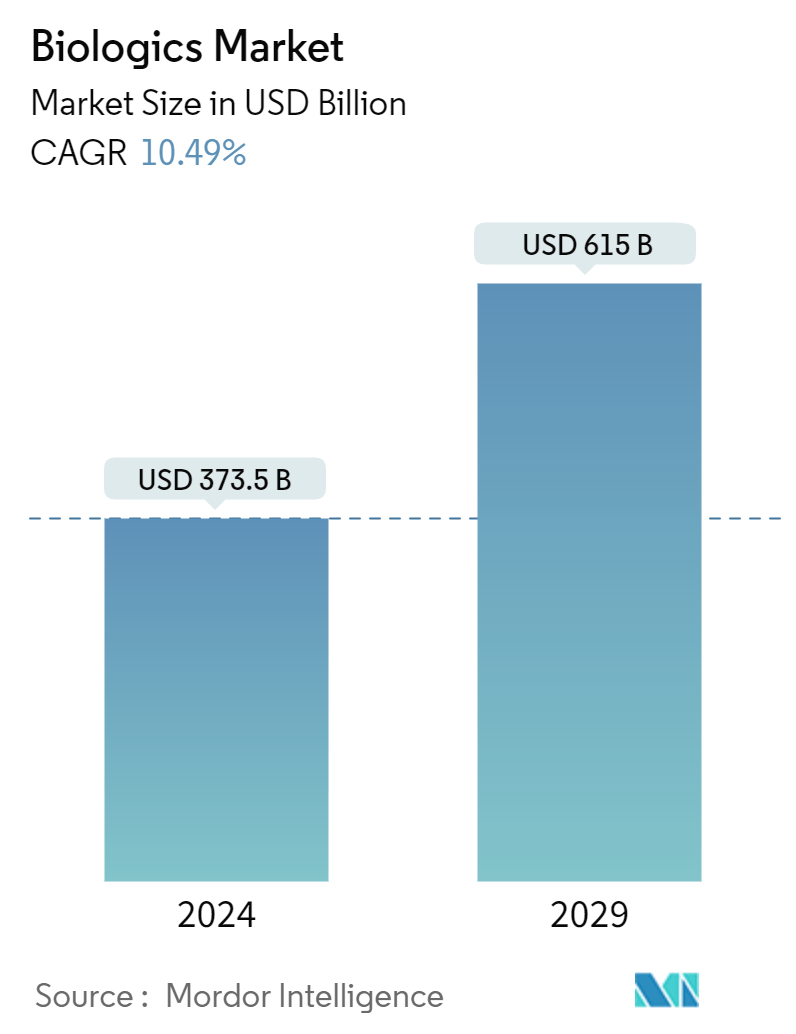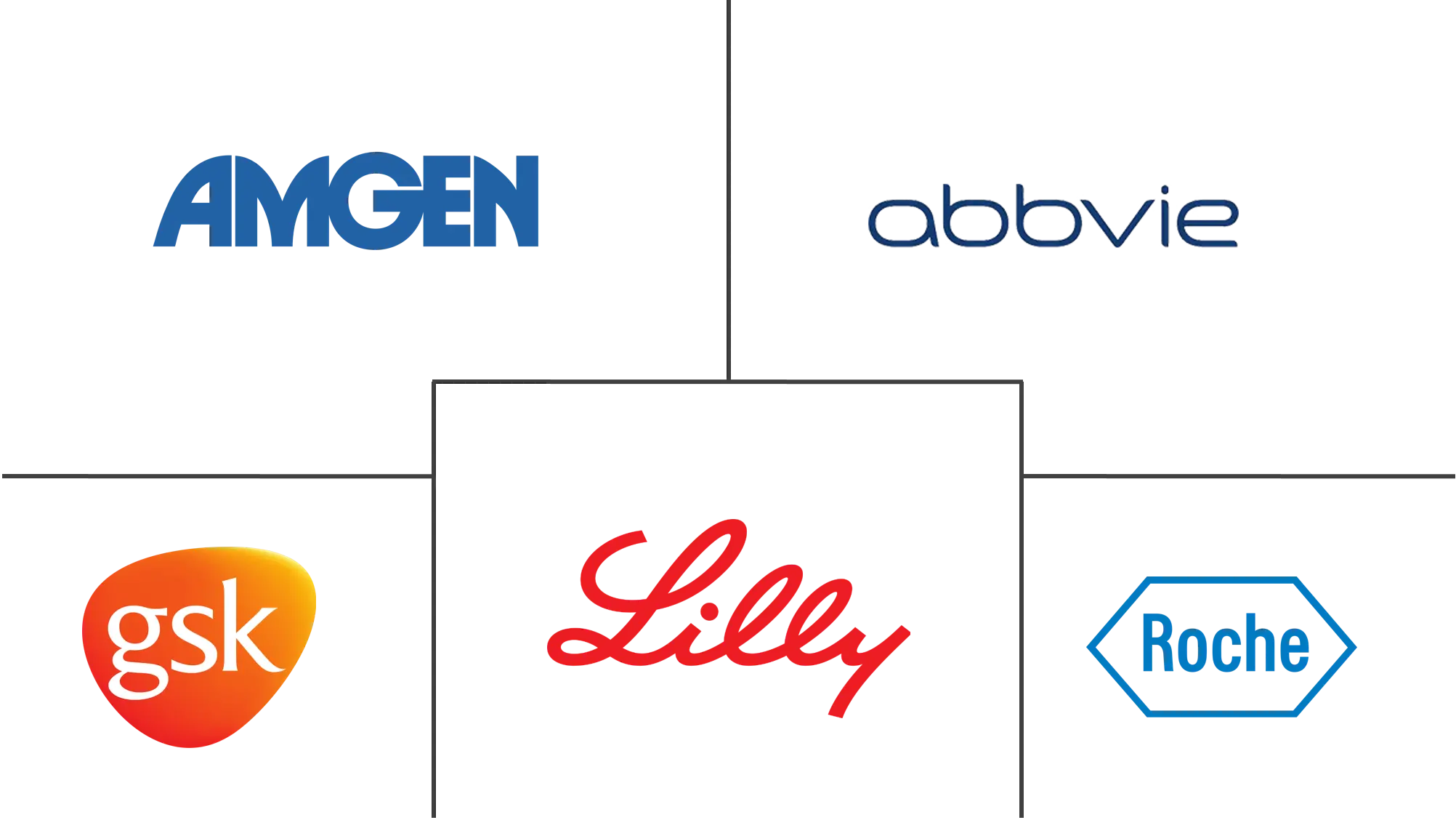Market Size of Biologics Industry

| Study Period | 2019 - 2029 |
| Market Size (2024) | USD 373.5 Billion |
| Market Size (2029) | USD 615 Billion |
| CAGR (2024 - 2029) | 10.49 % |
| Fastest Growing Market | Asia Pacific |
| Largest Market | North America |
Major Players
*Disclaimer: Major Players sorted in no particular order |
Biologics Market Analysis
The Biologics Market size is estimated at USD 373.5 billion in 2024, and is expected to reach USD 615 billion by 2029, growing at a CAGR of 10.49% during the forecast period (2024-2029).
The biologics industry is majorly driven by growing capital investment from key players, the rise in the burden of chronic diseases, the loss of patent exclusivity of the leading biologic drugs, and the increasing demand for and higher acceptability of innovative therapies.
According to the WHO report published in September 2023, non-communicable diseases (NCDs) cause 41 million deaths yearly, which is equivalent to 74% of the total death rate. Annually, 17 million individuals succumb to non-communicable diseases (NCDs) before reaching the age of 70, with a substantial 86% of these premature fatalities concentrated in low- and middle-income countries. A predominant 77% of NCD-related deaths occur within the same demographic. The primary contributors to NCD mortality are cardiovascular diseases, claiming 17.9 million lives each year, trailed by cancers (9.3 million), chronic respiratory diseases (4.1 million), and diabetes (2.0 million, including diabetes-induced kidney disease deaths). Collectively, these four disease categories contribute to over 80% of all premature NCD deaths. Factors such as tobacco use, physical inactivity, harmful alcohol consumption, unhealthy dietary practices, and air pollution significantly elevate the risk of succumbing to NCDs. The increasing cases of chronic diseases are expected to increase the demand for biologics further in treating chronic diseases.
The biologics market growth is fueled in part by increased investments. In October 2023, Syngene International, a subsidiary of Biocon Ltd, unveiled an annual investment plan surpassing USD 100 million, focusing primarily on advancing research, biologics, and small molecules. Over the past five years, the company has committed a cumulative investment of approximately USD 54 million (INR 4,500 crores).
Furthermore, in March 2023, Teva made a substantial investment exceeding USD 1 billion in biologics in Europe. Recognizing the escalating demand for biopharmaceutical products, Teva has allocated funds to enhance biologics production technologies, specifically for Active Pharmaceutical Ingredients (APIs) involving cells for biosimilars and novel biologics. Teva's robust pipeline encompasses biosimilars and novel biologic products across various therapeutic areas, and it is poised for delivery to patients in the coming years. At present, biotech products available in the market are manufactured within Teva's biologics production facilities in Ulm, Germany, and Vilnius, Lithuania, as well as through collaborations with external entities in Asia and the US.
In addition, biologics' rising research and development activities support the biologics market's growth. For instance, in March 2023, Catalent signed a licensing agreement with Bhami Research Laboratory (BRL) based in India. This strategic collaboration grants Catalent access to BRL's advanced formulation technology. The primary objective for Catalent is to leverage this technology to facilitate the development of formulations, enabling the subcutaneous administration of high-concentration biologics. This empowers Catalent to engage in collaborative assessments with its clients, exploring the potential of BRL's formulation technology to reduce viscosity and enhance the delivery of high-concentration biologic products. BRL's technology exhibits versatility, applying various monoclonal antibodies and fusion proteins. Successful outcomes from this collaboration may lead to integrating these programs into Catalent's comprehensive formulation and manufacturing services on a larger scale.
Furthermore, biologics product launches by the key market players are anticipated to drive the market's growth. For instance, in July 2023, Biocon Biologics officially announced the availability of HULIO (adalimumab-fkjp) injection, a biosimilar to Humira (adalimumab), for patients in the United States. This milestone follows five years of successful experience with HULIO in Europe and another two years in Canada. The introduction of HULIO to the US market represents a significant expansion of its global presence. It offers patients in the United States access to a well-established and proven biosimilar option.
Moreover, in July 2022, Brii Biosciences Limited, in collaboration with TSB Therapeutics (Beijing) Co. Ltd, a majority-owned joint venture, officially launched the commercial availability of the amubarvimab/romlusevimab combination in China. The release of the initial commercial batch of these long-acting COVID-19 neutralizing antibodies on July 7 signified a significant achievement in advancing the commercialization of this innovative combination therapy.
Thus, the above-mentioned factors are anticipated to drive the biologics industry's growth during the next five years. However, the stringent regulatory processes, high capital investment, and loss of patent exclusivity are likely to restrain the market's growth.
Biologics Industry Segmentation
The term "biologics" refers to large, complex molecules made in living cells grown in a laboratory. Biologic medicines are often 200 to 1,000 times the size of a small molecule or chemical drug. Due to their large molecular size and fragile molecular structure, biologics are majorly delivered through parenteral routes.
The biologics industry report is segmented by product, application, source, and geography. The product is further segmented into monoclonal antibodies, vaccines, recombinant hormones/proteins, cellular-based biologics, gene-based biologics, and other products. The application is divided into cancer, infectious, autoimmune, and other applications. The source is further bifurcated into microbial and mammalian. Geography segmented is further divided into North America, Europe, Asia-Pacific, Middle East and Africa, and South America. The biologics report also covers the estimated market size and trends for 17 countries across major global regions. The report offers the biologics market size and forecasts in value in USD for all the above-mentioned segments.
| By Product | |
| Monoclonal Antibodies | |
| Vaccines | |
| Recombinant Hormones/Proteins | |
| Cellular-based Biologics | |
| Gene-based Biologics | |
| Other Products |
| By Application | |
| Cancer | |
| Infectious Diseases | |
| Autoimmune Diseases | |
| Other Applications |
| By Source | |
| Microbial | |
| Mammalian |
| By Geography | ||||||||
| ||||||||
| ||||||||
| ||||||||
| ||||||||
|
Biologics Market Size Summary
The biologics market is poised for significant growth, driven by increased capital investments, the rising prevalence of chronic diseases, and the demand for innovative therapies. The industry is experiencing a surge in research and development activities, with major players like Syngene International and Teva making substantial investments to enhance biologics production technologies and expand their product pipelines. The market is also witnessing strategic collaborations, such as Catalent's partnership with Bhami Research Laboratory, aimed at advancing formulation technologies for high-concentration biologics. These efforts are expected to bolster the availability and delivery of biologic products, further propelling market expansion. Additionally, the introduction of new biologic products, such as Biocon Biologics' HULIO and Brii Biosciences' COVID-19 neutralizing antibodies, underscores the industry's commitment to addressing global health challenges.
The North American region dominates the global biologics market, supported by a robust presence of pharmaceutical and biotech companies and a high incidence of chronic diseases. The increasing prevalence of cancer, particularly in the United States, is driving demand for biologic treatments, with new product launches by key players like Pfizer Inc. and BioNTech SE contributing to market growth. The industry is moderately competitive, with major companies such as Amgen, Inc., Eli Lilly and Company, and Abbvie Inc. actively engaging in strategic initiatives to strengthen their market positions. Despite challenges like stringent regulatory processes and high capital requirements, the biologics market is expected to continue its upward trajectory, supported by ongoing innovations and strategic partnerships.
Biologics Market Size - Table of Contents
-
1. MARKET DYNAMICS
-
1.1 Market Overview
-
1.2 Market Drivers
-
1.2.1 Growing Capital Investment from Key Market Players
-
1.2.2 Rise in the Prevalence of Chronic Diseases
-
1.2.3 Growing Demand and Higher Acceptability for Innovative Therapies
-
-
1.3 Market Restraints
-
1.3.1 Stringent Regulatory Process and Initial High Capital Investment
-
1.3.2 Rising Control and Cost for Accessing Biologics
-
1.3.3 Loss of Patent Exclusivity of the Leading Biologic Drugs
-
-
1.4 Porter's Five Forces Analysis
-
1.4.1 Threat of New Entrants
-
1.4.2 Bargaining Power of Buyers/Consumers
-
1.4.3 Bargaining Power of Suppliers
-
1.4.4 Threat of Substitute Products
-
1.4.5 Intensity of Competitive Rivalry
-
-
-
2. MARKET SEGMENTATION (Market Size by Value - USD)
-
2.1 By Product
-
2.1.1 Monoclonal Antibodies
-
2.1.2 Vaccines
-
2.1.3 Recombinant Hormones/Proteins
-
2.1.4 Cellular-based Biologics
-
2.1.5 Gene-based Biologics
-
2.1.6 Other Products
-
-
2.2 By Application
-
2.2.1 Cancer
-
2.2.2 Infectious Diseases
-
2.2.3 Autoimmune Diseases
-
2.2.4 Other Applications
-
-
2.3 By Source
-
2.3.1 Microbial
-
2.3.2 Mammalian
-
-
2.4 By Geography
-
2.4.1 North America
-
2.4.1.1 United States
-
2.4.1.2 Canada
-
2.4.1.3 Mexico
-
-
2.4.2 Europe
-
2.4.2.1 Germany
-
2.4.2.2 United Kingdom
-
2.4.2.3 France
-
2.4.2.4 Italy
-
2.4.2.5 Spain
-
2.4.2.6 Rest of Europe
-
-
2.4.3 Asia-Pacific
-
2.4.3.1 China
-
2.4.3.2 Japan
-
2.4.3.3 India
-
2.4.3.4 Australia
-
2.4.3.5 South Korea
-
2.4.3.6 Rest of Asia-Pacific
-
-
2.4.4 Middle East and Africa
-
2.4.4.1 GCC
-
2.4.4.2 South Africa
-
2.4.4.3 Rest of Middle East and Africa
-
-
2.4.5 South America
-
2.4.5.1 Brazil
-
2.4.5.2 Argentina
-
2.4.5.3 Rest of South America
-
-
-
Biologics Market Size FAQs
How big is the Biologics Market?
The Biologics Market size is expected to reach USD 373.5 billion in 2024 and grow at a CAGR of 10.49% to reach USD 615 billion by 2029.
What is the current Biologics Market size?
In 2024, the Biologics Market size is expected to reach USD 373.5 billion.

